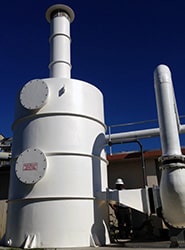
When it comes to starting up a biological scrubber tower, ensuring proper acclimation is crucial to avoid costly shutdowns and ensure optimal performance.
This is especially important for projects involving the removal of acid gases, such as Hydrogen Sulfide (H2S). Acclimating the biological scrubber tower to specific conditions is essential to guarantee efficient gas removal.
A helpful analogy for understanding the acclimation process is to imagine taking care of a new aquarium. Just as introducing fish too quickly can cause shock or potential harm, improper conditions in a biological scrubber tower can lead to unfavorable results. Factors such as water temperature and pH balance play significant roles in the acclimation process.
One common challenge arises when the off-gas loading rate is inconsistent or rapidly fluctuates.
Such variations can create difficulties during the initial balancing and operation of the scrubber. To address this, it is important to bring the scrubber online and establish a steady state for all the essential parameters. The specific type of cultures being treated will determine the necessary conditions for successful acclimation. Given the right conditions and sufficient time, the microbes will adapt and acclimate to the media structure within the scrubber tower.
To facilitate the acclimation process, a substitute feed source is often utilized to promote colonization on the media surface and increase the microbe count. However, it is crucial to note that acclimating the microbes to the intended off-gas requires a gradual transition. Abrupt changes can lead to microbial mortality and a subsequent decline in scrubber performance.
Ideally, the acclimation process should involve using the specific gas that the scrubber intends to treat. Although this approach may initially result in lower removal efficiency, gradually over a period of 3-5 days, improvements will be observed until the optimal loading rate is achieved.
For comprehensive information and expert guidance on the acclimation process and achieving optimal performance in biological scrubber towers, reach out to the professionals at DeLoach Industries Inc. With our extensive experience in the field, we specialize in a range of solutions, including spiral-pac-type tower packing, pack media, packed tower scrubbers, odor control scrubbers, degasification, and decarbonation. Our expertise extends to addressing various gaseous pollutants and ensuring effective treatment through tower-type scrubbers. To learn more, please contact us at (941) 371-4995.
At DeLoach Industries Inc., we are committed to providing you with the knowledge and support needed to navigate the challenges of biological scrubber tower acclimation. Our team of professionals is dedicated to delivering reliable and efficient solutions tailored to your specific requirements. Contact us today to discover how we can assist you in achieving optimal performance in your water treatment endeavors.
Receive Your Free Odor Control E-Book
Related Blog: What to Consider When Selecting an Odor Control Scrubber [VIDEO]





